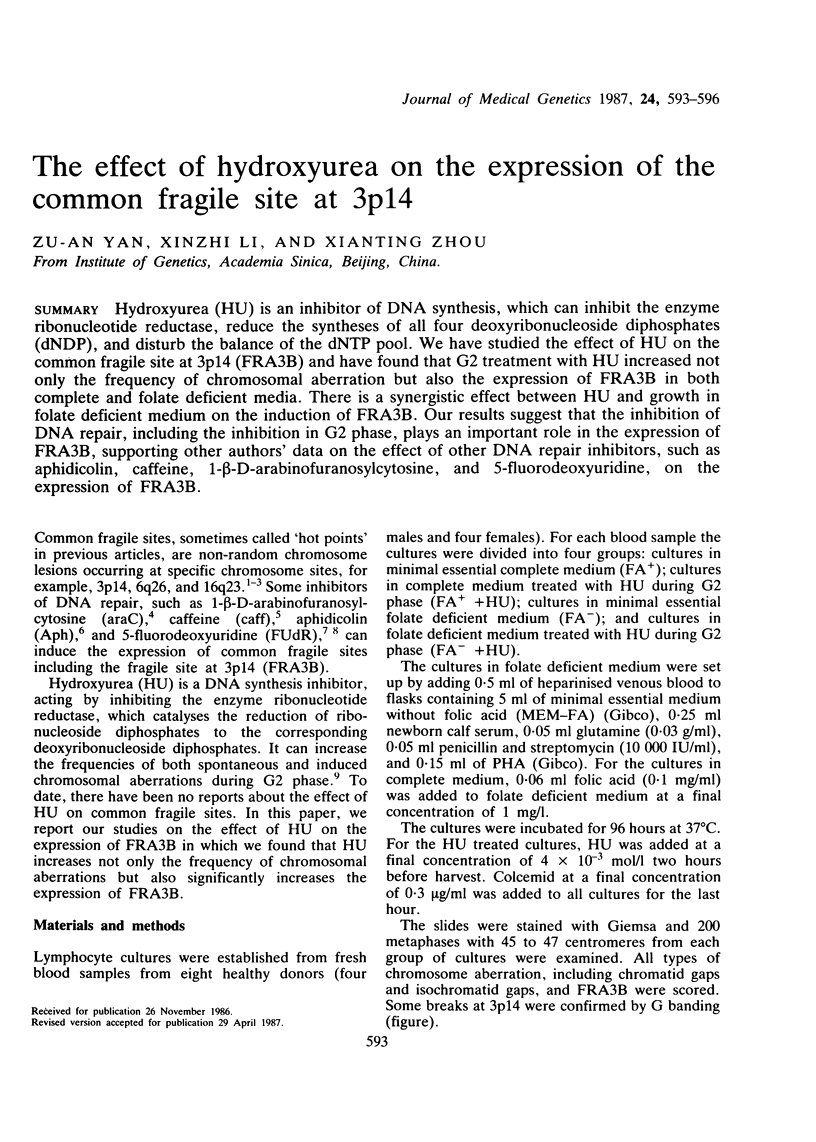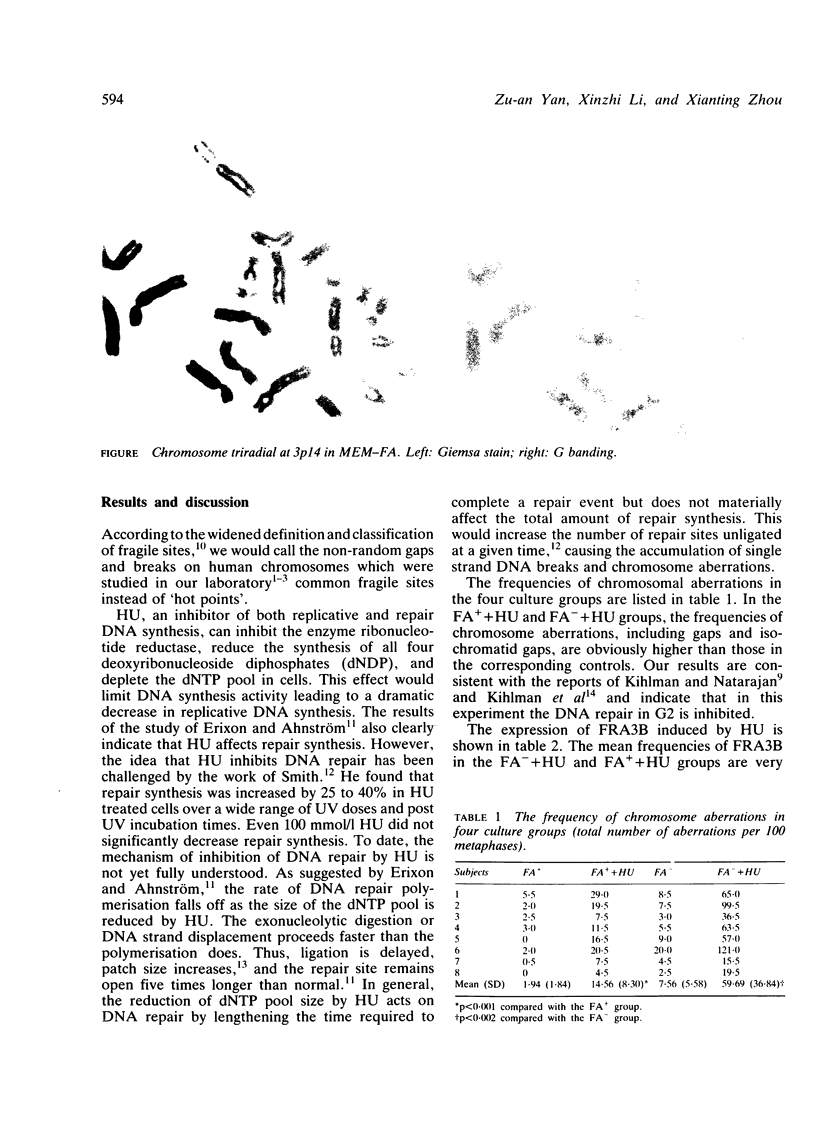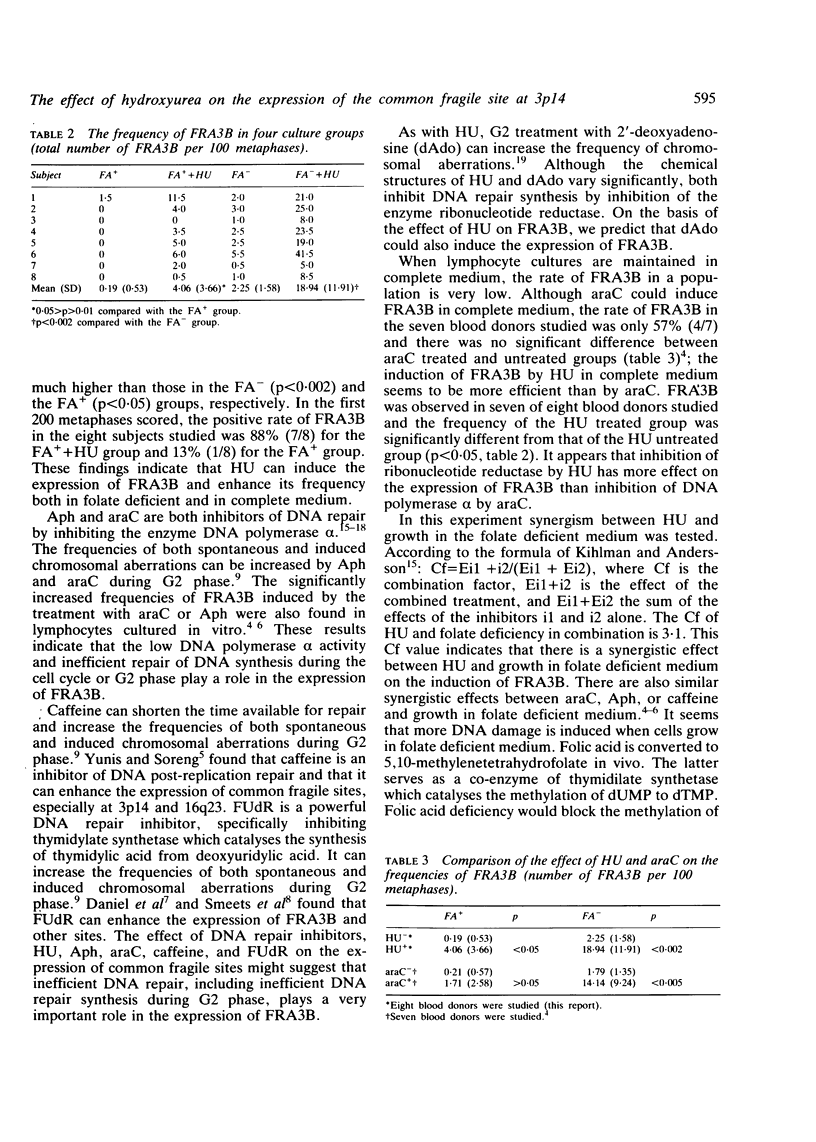Abstract
Hydroxyurea (HU) is an inhibitor of DNA synthesis, which can inhibit the enzyme ribonucleotide reductase, reduce the syntheses of all four deoxyribonucleoside diphosphates (dNDP), and disturb the balance of the dNTP pool. We have studied the effect of HU on the common fragile site at 3p14 (FRA3B) and have found that G2 treatment with HU increased not only the frequency of chromosomal aberration but also the expression of FRA3B in both complete and folate deficient media. There is a synergistic effect between HU and growth in folate deficient medium on the induction of FRA3B. Our results suggest that the inhibition of DNA repair, including the inhibition in G2 phase, plays an important role in the expression of FRA3B, supporting other authors' data on the effect of other DNA repair inhibitors, such as aphidicolin, caffeine, 1-beta-D-arabinofuranosylcytosine, and 5-fluorodeoxyuridine, on the expression of FRA3B.
Full text
PDF



Images in this article
Selected References
These references are in PubMed. This may not be the complete list of references from this article.
- Berger R., Bloomfield C. D., Sutherland G. R. Report of the Committee on Chromosome Rearrangements in Neoplasia and on Fragile Sites. Cytogenet Cell Genet. 1985;40(1-4):490–535. doi: 10.1159/000132181. [DOI] [PubMed] [Google Scholar]
- Collins A. R., Downes C. S., Johnson R. T. Introduction: an integrated view of inhibited repair. Nucleic Acids Symp Ser. 1984;(13):1–11. [PubMed] [Google Scholar]
- Daniel A., Ekblom L., Phillips S. Constitutive fragile sites 1p31, 3p14, 6q26, and 16q23 and their use as controls for false-negative results with the fragile(X). Am J Med Genet. 1984 Jul;18(3):483–491. doi: 10.1002/ajmg.1320180318. [DOI] [PubMed] [Google Scholar]
- Erixon K., Ahnström G. Single-strand breaks in DNA during repair of UV-induced damage in normal human and xeroderma pigmentosum cells as determined by alkaline DNA unwinding and hydroxylapatite chromatography: effects of hydroxyurea, 5-fluorodeoxyuridine and 1-beta-D-arabinofuranosylcytosine on the kinetics of repair. Mutat Res. 1979 Feb;59(2):257–271. doi: 10.1016/0027-5107(79)90164-7. [DOI] [PubMed] [Google Scholar]
- Glover T. W., Berger C., Coyle J., Echo B. DNA polymerase alpha inhibition by aphidicolin induces gaps and breaks at common fragile sites in human chromosomes. Hum Genet. 1984;67(2):136–142. doi: 10.1007/BF00272988. [DOI] [PubMed] [Google Scholar]
- Ikegami S., Taguchi T., Ohashi M., Oguro M., Nagano H., Mano Y. Aphidicolin prevents mitotic cell division by interfering with the activity of DNA polymerase-alpha. Nature. 1978 Oct 5;275(5679):458–460. doi: 10.1038/275458a0. [DOI] [PubMed] [Google Scholar]
- Kihlman B. A., Andersson H. C. Synergistic enhancement of the frequency of chromatid aberrations in cultured human lymphocytes by combinations of inhibitors of DNA repair. Mutat Res. 1985 Jun-Jul;150(1-2):313–325. doi: 10.1016/0027-5107(85)90128-9. [DOI] [PubMed] [Google Scholar]
- Kihlman B. A., Andersson H. C. The effect of G2-treatments with 2'-deoxyadenosine on the frequency of chromatid aberrations in human lymphocytes depends on the type of culture. Chromosoma. 1984;90(4):239–242. doi: 10.1007/BF00287030. [DOI] [PubMed] [Google Scholar]
- Kihlman B. A., Natarajan A. T. Potentiation of chromosomal alterations by inhibitors of DNA repair. Nucleic Acids Symp Ser. 1984;(13):319–339. [PubMed] [Google Scholar]
- Li N., Wu Y., Zhou X. T. Human chromosome hot points. V. The effect of four nucleosides on chromosomes in folate-free medium. Hum Genet. 1986 Sep;74(1):101–103. doi: 10.1007/BF00278795. [DOI] [PubMed] [Google Scholar]
- Li N., Zhou X. T. Human chromosome hot points. IV. Uridine-induced hot-point breaks at 3p14 and 16q23-24 and increased expression of fragile site Xq27 in folate-free medium. Hum Genet. 1985;71(4):363–365. doi: 10.1007/BF00388465. [DOI] [PubMed] [Google Scholar]
- Li X. Z., Yan Z. A., Zhou X. T. The effect of 1-beta-D-arabinofuranosyl-cytosine on the expression of the common fragile site at 3p14. Hum Genet. 1986 Dec;74(4):444–446. doi: 10.1007/BF00280503. [DOI] [PubMed] [Google Scholar]
- Smeets D. F., Scheres J. M., Hustinx T. W. The most common fragile site in man is 3p14. Hum Genet. 1986 Mar;72(3):215–220. doi: 10.1007/BF00291880. [DOI] [PubMed] [Google Scholar]
- Snyder R. D., Van Houten B., Regan J. D. The accumulation of DNA breaks due to incision; comparative studies with various inhibitors. Nucleic Acids Symp Ser. 1984;(13):13–33. [PubMed] [Google Scholar]
- Zhou X. T., Xu B. H., Chu C. L., Xia G. F., Li N., Sha R. Human chromosome hot points. 1. Hot point at 3p14 in three populations. Hum Genet. 1984;67(3):249–251. doi: 10.1007/BF00291350. [DOI] [PubMed] [Google Scholar]



